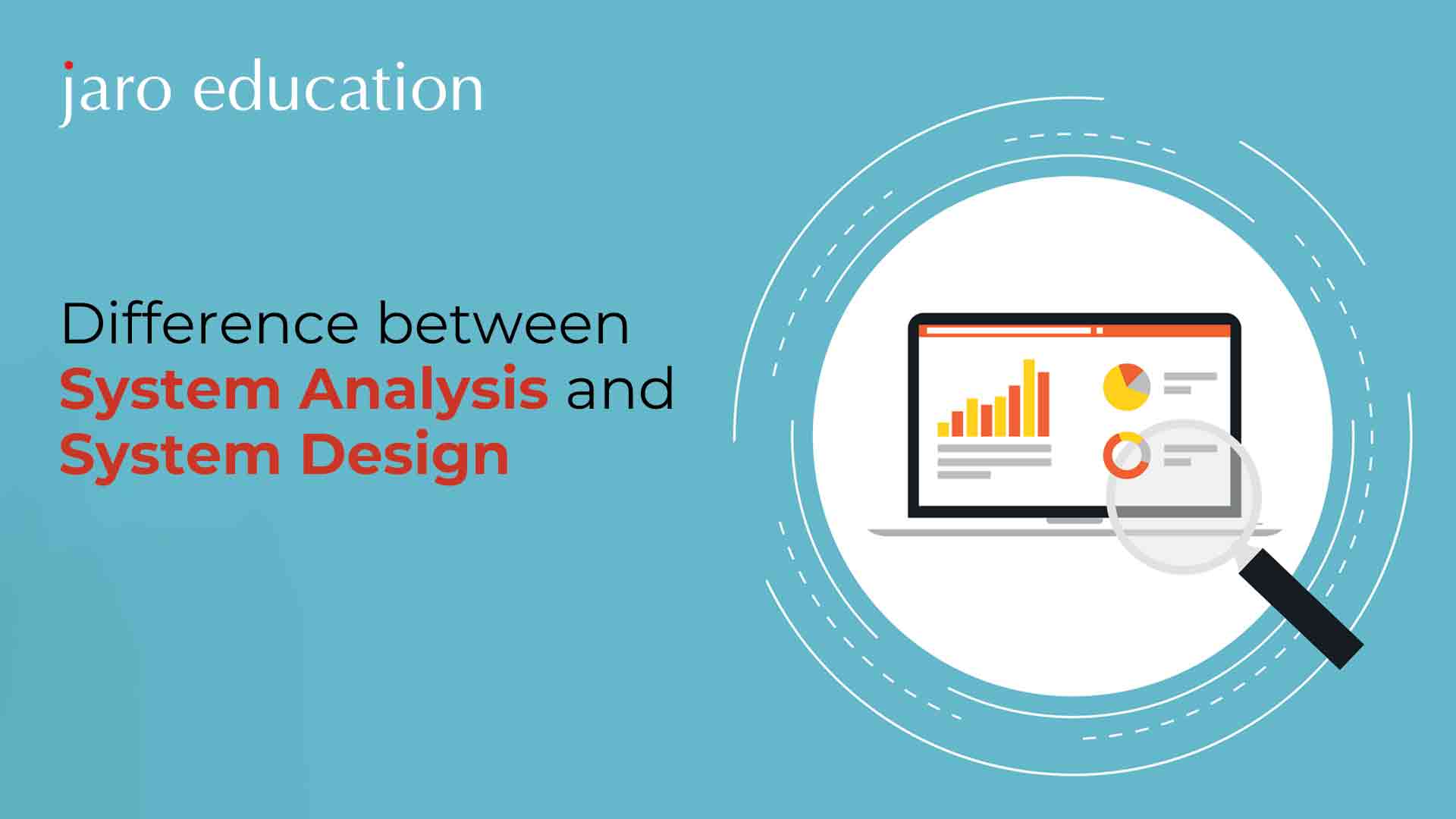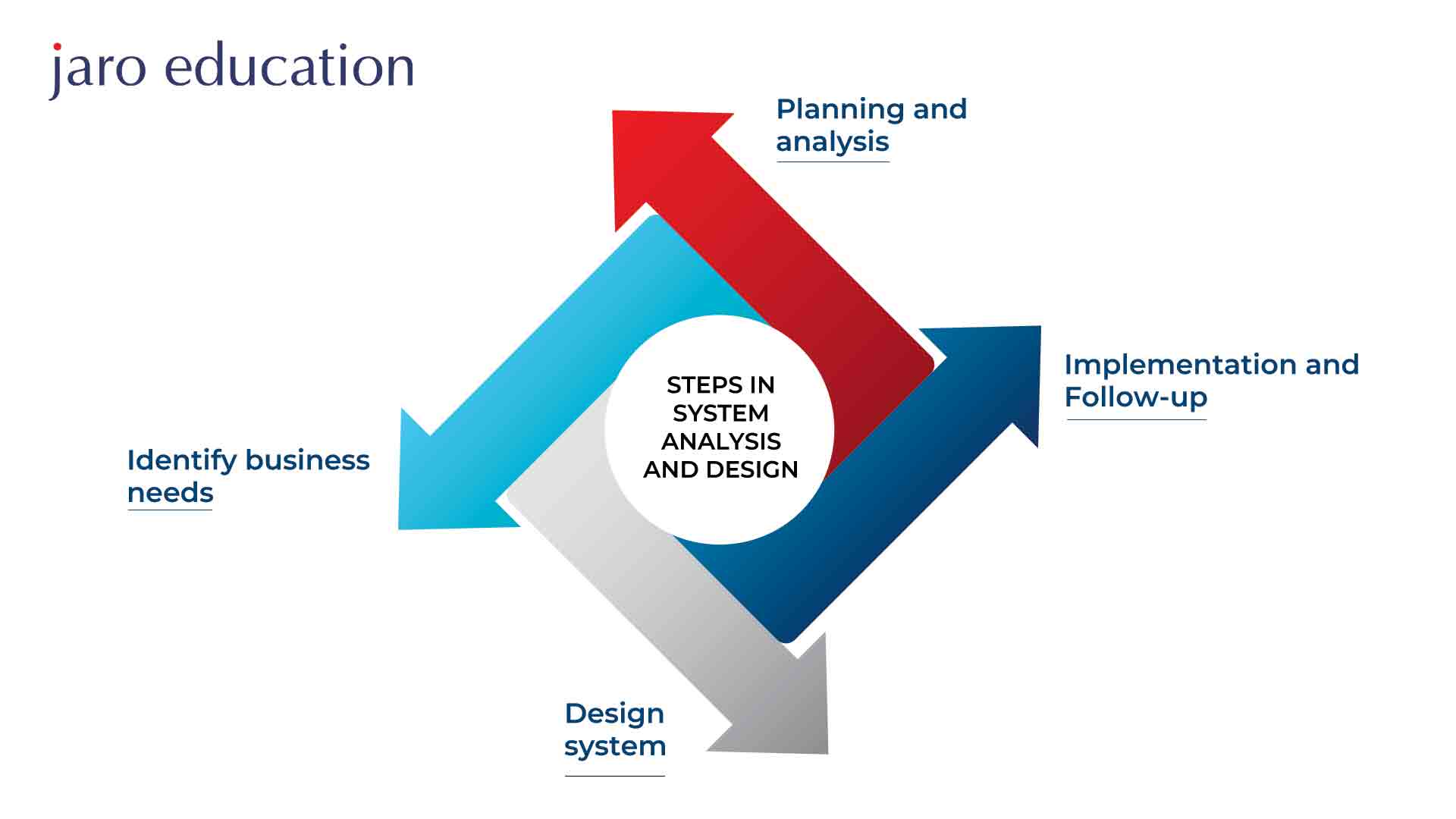Difference between System Analysis and System Design
Table of Contents

- jaro education
- 26, November 2023
- 5:00 pm
Software development is a multi-stage process that involves building reliable and effective systems. System Analysis and System Design are two of the most crucial phases of this process. Both of them are essential to the creation of software, but they have quite different goals, strategies, ranges of applications, processes, and final products. The contrasts between System Analysis and System Design will be thoroughly discussed in this blog, along with what is system analysis and design, its advantages, disadvantages, and wider consequences for software development.
System Analysis: Uncovering the Essentials
The life cycle of software development begins with system analysis. The foundation upon which the entire system is constructed is represented by it. In the present world, understanding the current system, evaluating its advantages and disadvantages, and, more importantly, identifying the specifications for a new system are the main goals.
Characteristics of System Analysis
The characteristics are as follows:
Study of Existing System
System analysis begins with a thorough assessment of the current system. This includes a close examination of its parts, capabilities, and operation. The goals are to gain a thorough grasp of how the current system functions and identify areas that need improvement.
Understanding System Requirements
One of the main goals of system analysis is to identify and comprehend the system’s requirements. To assess the system in totality, gathering and understanding the functional and non-functional requirements are necessary because they serve as the development process guiding principles.
User-Centric Approach
System Analysis lays a major emphasis on the desires and expectations of the end-users in the process of obtaining requirements. Meeting user expectations is vital and system analysis is done predominantly focusing on the requirements of customers.
Analysis for Current and Future Needs
System Analysis goes beyond just assessing the current state of the system; it also takes into account future needs and scalability, enabling the creation of a system that is not just functional today but remains relevant in the years to come.
Limitations of System Analysis
The drawbacks of system analysis are as follows:
Time-Consuming
System Analysis can be a time-consuming process, as thoroughly assessing an existing system and gathering requirements demands a significant investment of time.
Costly
The resources required for conducting a comprehensive System Analysis, including skilled personnel, tools, and infrastructure, can incur significant costs.
Data Accuracy Challenges
Acquiring accurate information can be a challenge in some cases. Users might not always provide precise or complete data, which can hinder the accuracy of the analysis.
What is System Design?
Once System Analysis has laid the groundwork by identifying requirements and problem areas, System Design creates the blueprint for the new system. It involves the process of specifying the system’s architecture, components, modules, interfaces, and data structures, all designed to meet the identified requirements.
Characteristics of System Design
The characteristics are as follows:
Creating a Design
At its core, System Design is the process of designing the system. This involves structuring the architecture specifying components, modules, interfaces, and data storage schemes.
Identifying Modules and Components
System Design revolves around the specifics of identifying the individual modules and components that constitute the system. It outlines the functionality and interrelationships of these modules and components.
User Interface and Database Design
Database design involves creating the user interface, ensuring that it is user-friendly and intuitive. It encompasses designing the database to efficiently store and retrieve data.
Limitations of System Design
The drawbacks of system design are as follows:
Time-Consuming
Similar to System Analysis, System Design can be a time-consuming endeavour, especially if intricate system architectures are involved.
Costly
The design phase may also entail considerable costs, particularly when employing highly skilled designers and specialised design tools.
Data Accuracy Challenges
Accurate information is crucial for design. Inaccurate or incomplete data from the analysis phase can hinder the quality of the design.

Differences Between System Analysis and System Design
Now, let’s look into the specific differences between System Analysis and System Design, categorising them based on various factors:
Purpose
System Analysis: Completion of Initial Data Collection
In System Analysis, the primary purpose is to assess the suitability of the existing system and define the requirements for the new system. This phase involves understanding the user’s needs and identifying issues in the current system.
System Design: Post Data Collection and Specification of Elements
System Design, on the other hand, is all about specifying the system’s elements, including modules, architecture, components, and their interfaces, after the collection of data. Its primary aim is to create a blueprint for the system, outlining how it will be structured and how its components will interact.
Approach
System Analysis: A Broad Top-Down Approach
System Analysis typically follows a top-down approach, where analysts begin by examining the big picture and then delve into the details. This approach helps in understanding the broader context before focusing on specifics.
System Design: A Detail-Oriented Bottom-Up Approach
System Design takes a bottom-up approach, commencing with the finer details and gradually building up to the big picture. This approach allows for a more detailed and refined understanding of how the system components will work together.
Scope
System Analysis: Helps Identify the Main Objectives
The scope of System Analysis revolves around understanding the prime goals of a software development process. The evaluation of the existing system and the business processes is carried out to come up with a viable solution according to the goal.
System Design: Helps Define the System's Structure
System Design focuses on designing the system itself, including its architecture and the components that make up the system. Also, it defines how the system will meet the requirements identified during analysis.
Output
System Analysis: Create Important User-Based Documents
System Analysis creates a system specific document. This document outlines the desired system based on user needs and the identified issues in the current system, serving as a foundation for design.
System Design: Create Design Documents
System Design creates a design document that details the system’s architecture, components, and interfaces, thereby providing a clear plan for the system’s construction.
Time
System Analysis: One Time Process
System Analysis is typically a one-time process that occurs at the beginning of the project. It sets the stage for the subsequent development phases.
System Design: An Ongoing and Adaptive Process
System Design is an ongoing process that continues throughout the project, adapting to evolving requirements and design challenges, making it a continuous effort.
Methodology
System Analysis: Structured and Methodical Approach
System Analysis often relies on structured approaches, such as the Waterfall Model or Agile Methodology, to systematically gather and analyse information.
System Design: Iterative and Adaptive Strategies
System Design often adopts iterative approaches, such as the Spiral Model, allowing for refinement and adjustment during the design process, responding to changing requirements.
Tools
System Analysis: Tools for Data Gathering and Analysis
System Analysis utilises tools like interviews, surveys, questionnaires, and observation to gather and analyse information from users and stakeholders.
System Design: Visual Tools for System Specification
System Design employs tools such as data flow diagrams and object-oriented diagrams to create the design and specify system components, helping in visualising the system’s structure.
Process
System Analysis: Initiating the Software Development Journey
System Analysis is the initial step in the software development process, setting the stage for subsequent development phases like design and implementation.
System Design: Translating Requirements into a Concrete Design
System Design follows System Analysis as the second step in the software development process. It involves translating the requirements into a concrete and comprehensive design.
Goals
System Analysis: Understanding and Identifying User Needs
The primary goal of System Analysis is to identify and understand user requirements and the business processes the system must support. It mainly focuses on problem identification.
System Design: Problem-Solving and Design Creation
The goal of System Design is to create a comprehensive design that meets the user requirements and effectively supports the identified business processes. It shifts the focus towards problem-solving and devising solutions based on the identified issues.
Risk
System Analysis: Minimal Risk in Problem Identification
System Analysis typically involves minimal risk, as it primarily focuses on problem identification and understanding user needs.
Risk in Aligning Design with Requirements
System Design carries a higher risk, as the design may not always perfectly align with user requirements or effectively support business processes. It involves translating requirements into a concrete solution.
Problem-Solving
System Analysis: Identifying and Defining Problems
System Analysis mainly concentrates on identifying and defining problems, aiming to understand the issues with the existing system.
System Design: Problem-Solving and Solution Development
System Design shifts the focus towards problem-solving and devising solutions based on the identified issues. It aims to create a design that effectively addresses these problems.
Conclusion
In the world of software development, System Analysis and System Design stand as distinct yet interconnected stages. System Analysis serves as the bedrock, anchoring the process with its focus on understanding the existing system and the needs of the users. It identifies issues, extracts requirements, and sets the stage for System Design. On the other hand, System Design builds upon the groundwork laid by System Analysis. It is the phase where the blueprint for the new system is created, focusing on efficiency, cost reduction, and a better user experience. A collaborative and iterative approach between these two stages, incorporating user feedback and evolving requirements, can significantly enhance the final product’s quality and relevance.
If you want to learn system analysis and design at your own convenience, the Online Master of Computer Applications (MCA) – Manipal University Jaipur can be of your interest, as it will help you learn the intricacies of system design and analysis with prominent faculty associated with the prestigious university and gain a global tech perspective. This well-known programme also provides hands-on training in cloud computing, Big Data, ML, etc. Most importantly, this programme allows participants to pursue this degree from the comfort of their homes with the help of live or recorded lectures. So hurry up and apply for this course through Jaro Education.







